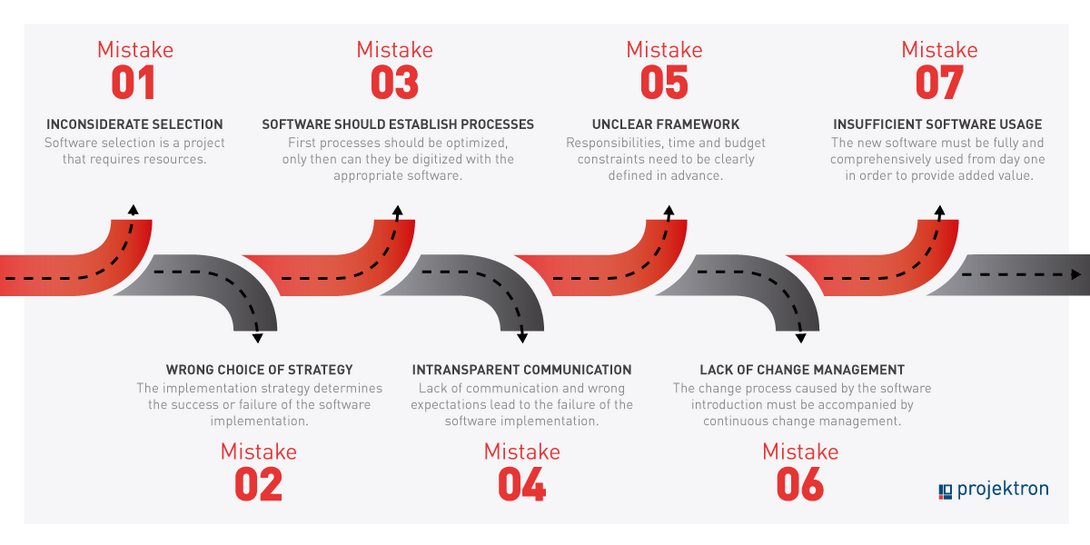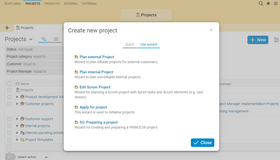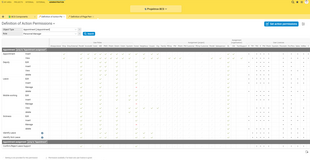05/31/2023 - Articles
Successfully implementing software: Avoid the 7 biggest mistakes
The rollout of complex software, whether ERP systems or project management software, is a significant project for companies of all sizes and industries - from small agencies to global corporations. In the worst case, a failure of a software implementation project can have devastating consequences and even threaten the existence of the company. What are the biggest risks in software implementation? How can you avoid serious mistakes so that your software introduction is a complete success?
The 7 biggest software implementation mistakes are:
- Ill-considered or overhasty software selection
- Wrong choice of software implementation strategy
- Software should establish processes
- Intransparent communication
- Unclear framework conditions
- Poor change management
- New system is not fully utilized
What exactly lies behind these mistakes and how you can effectively avoid them, you will learn below.
Mistake 1: Rash or overhasty software selection
Just because a software provider spends a lot of money on marketing, skillfully stages colorful views and promises full-bodied to be the eierlegende Wollmilchsau for every use case, its software does not necessarily have to do this for your company. In fact, it most likely won't in this case. The selection of project management software, ERP software or similar complex software products has an impact on all your internal and external business processes, on the way you work and on the day-to-day working reality of your employees.
Therefore, understand the selection of a suitable software as a project in which you should invest appropriate time, resources and effort. We have developed a 9-step plan for software selection that can serve as a rough guide for the selection process. Above all, take heed of step 9: A software test is essential!
Mistake 2: Incorrect software deployment strategy
Once you have successfully completed your selection project for a new enterprise software, you can initiate the software introduction project. In the definition phase of the implementation project, the choice of the appropriate implementation strategy is the central factor that determines the success or failure of the software implementation.
There are a variety of different implementation strategies:
- Software rollout according to the big bang method
- Project-oriented software rollout
- Functional iterative software rollout
- Regional or departmental iterative rollout
- Combined rollout strategies
When deciding on a strategy, you must evaluate the complex interaction of eleven different influencing factors and identify combinations of characteristics that exclude or make certain strategies mandatory. This task is too critical to be decided in-house alone. When introducing enterprise software, you should enlist the help of specialists and manage the introduction project together with the software provider's user consultants on a basis of trust.
Mistake 3: Software should establish processes
The motive for which companies decide to introduce ERP or project management software is usually that they are not satisfied with the flow and coordination of internal processes or want to fundamentally restructure them and make them more efficient. This is exactly what many software vendors promise in marketing texts: Each one supposedly offers the omnipotent universal tool that eliminates all your pain points without any intervention.
First, define your work processes and your workflows. Existing processes have grown historically and in many cases have long since been overtaken by time and are no longer the most efficient solution. How should your business areas mesh, which information flows should converge where to achieve what?
- Define concrete goals (SMART goals),
- develop a concept and
- describe your internal process map.
These individual processes defined by you should be part of your requirements catalog or specifications when you start looking for suitable software. This may seem like a lot of work at first, but it is a mistake to adapt your processes to the capabilities of the software. The software should adapt to your processes and provide you with the best possible support to execute them as automatically and efficiently as possible, not the other way around.
Therefore, the rule is: optimize processes first, then digitize them.
A good software manufacturer will take the time to get to know your processes and open up opportunities for you to optimally support them with individual configurations. He will be helped by concrete application scenarios/use cases that you describe in detail with desired goals. You should take the time for this.

Example of a concrete application scenario
Ms. Mustermann generates new invoices online, which she can also do in her home office. She uses predefined layouts, articles and prices. The addressee of the invoice is automatically taken from the CRM database. Finished invoices are sent directly from the software by e-mail. She can also make and send corrections and cancellations in the system.
Mistake 4: Non-transparent communication
One of the most prominent factors leading to project failure is a lack of or disrupted project communication. This is equally true for software implementation projects. Lack of communication and false expectations inevitably lead to the failure of your software introduction - with incalculable consequential damage.
Communication with the software provider must be characterized by mutual transparency and trust. However, this does not only mean that the software provider's consultant should make an effort for you, but it is your task as the client to clearly formulate and communicate your expectations. You can thus recognize a serious provider directly by the fact that he correctly and completely takes up your expectations and puts them into focus.
No matter which side causes it - if miscommunication occurs, poor decisions, inappropriate configurations and a strained relationship between contractor and client are often the consequences.
Expectations often only develop in the course of communication between the software provider and the prospective customer:
- Prospective customer formulates requirement: software that solves problem XY.
- The provider explains how his solution solves this problem. In doing so, it presents features and functions that also solve other problems.
- The prospect adjusts his expectations based on the possibilities presented and usually expands his horizon of expectations.
The more than two people are involved in this process and the more problems the software is to solve according to customer requirements, the more shifts and extensions of the original expectation horizon there will be. Therefore, it is also important in the course of the software introduction to formulate expectations transparently and to put them up for discussion. The more questions your consultant asks in the process, the better.
However, do not immediately break off negotiations if your ideas do not match the consultant's understanding at the beginning. A lack of clarity in communication cannot be avoided, is completely normal, especially at the beginning, and should be eliminated over time.
Mistake 5: Unclear general conditions
The software introduction of a project management or ERP software usually affects almost every department of your company. Naturally, at least the management, possibly the PMO, all project managers and department heads do not want to miss the opportunity to have a say in the selection and subsequent implementation. As we learned in Mistake 4, miscommunication is fueled as the number of sharing people increases.
Mistake 5 is therefore a classic: there is no clear person in charge. Too many people are talking, making clear and purposeful communication difficult.
In order to keep communication as direct as possible and implementation time as short as possible, it is therefore recommended that you appoint one person from your side as project manager.
The project manager...
- is the contact person and negotiator with the software company
- takes up the requirements and expectations within the own staff and represents these appropriately in the requirement catalog
- informs the workforce about the progress of the negotiations and the status of the implementation
- formulates and communicates requirements to the vendor
- initiates coordination and negotiation with the software vendor's consultant
- supervises the entire system implementation
The project manager should be given the resources necessary to see the project through from start to finish. A clear timeline and budget are also required. No implementation project of complex software is free and finished after two weeks.
Determine who will define the requirements even before a requirements catalog is created. Usually, this is the IT department on the one hand, and the business units that will use the software most intensively as lead users on the other. The primary interest of the IT department is that the new software integrates seamlessly into the existing system landscape. Lead users, on the other hand, pay attention to usability and functional aspects. The project manager should take up the interests of both parties and map them in the specifications.
Mistake 6: Poor change management
Introducing new enterprise software inevitably results in profound changes
- Work processes change for all users in your company.
- Old habits, structures and processes have to be questioned.
- Knowledge and information sovereignties are taken away through more transparency and simplified data access.
- Areas of activity change or even become obsolete.
It is understandable that not all those affected are enthusiastic about this. It is therefore perfectly normal for resistance to the system change to arise. The mistake is to deal with this resistance in the wrong way or not at all.
There are different forms of resistance, which must be dealt with in different ways:
- Open resistance: employees openly express their concerns. Encourage constructive criticism to expose real weaknesses in the software and the implementation process.
- Covert resistance: Employees express criticism only among themselves and sabotage the implementation by creating new requirements, insisting on secondary requirements, ignoring new process specifications, or expressing unspecific criticism of the user experience.
Resistance is usually caused by employees' fears of the changes described above:
- Fear of being overwhelmed
- Fear of losing power
- Fear of loss of control
The key to acceptance of the new software is therefore to prevent these fears and - where they do occur almost inevitably - to counter them with appropriate measures. It is therefore advisable to accompany the change process through the software introduction with continuous change management. Change management should always be a sub-project within the software introduction project and should be regarded as an integral part of the project.
Among other things, it involves preparing those affected for the upcoming changes at an early stage by providing comprehensive and appropriate information ("change communication") and involving them in shaping the change throughout the entire process. Change management in this sense is extremely diverse and can include a wide range of different measures, including information and training measures.
Representatives of sustainable change processes clearly advocate the earliest possible involvement of all stakeholders, i.e., all future software users. Consultants from experienced software providers can prevent resistance and create acceptance through appropriate training and workshops even before the actual introduction of the software. Knowledge of software usage gives affected employees the necessary security in the process. The greater the security, the greater the willingness to change.
Mistake 7: The new system is not fully used
In order for complex business software to fulfill its actual purpose, namely to handle internal company processes more efficiently, all relevant data must first be initially imported and then continuously maintained. Especially directly after the introduction of the new software, it is important to establish a routine for data maintenance in all departments. Data maintenance does not seem to bring any immediate benefit to the individual users themselves and therefore means unnecessary effort for them.
In many cases, the employee who would have to feed information into the system is not the one who benefits from it afterwards. Therefore, there is a temptation to treat documentation and data maintenance stepmotherly. However, this leads to a patchy database and to the software being used and maintained even less by employees and, ultimately, to the software being useless and workflows collapsing.

This phenomenon is also known as the "shared resources dilemma" or "dilemma of shared resources": a poorly maintained system offers no added value for employees, which is why they do not continue to maintain it.
You can reverse this effect and use it to your advantage. A user who finds information in the system quickly and considers it helpful is also inclined to enter detailed data. You should therefore establish appropriate incentives from the first day of software use. Various features and functions provided by the software itself can be used for this purpose:
- When selecting software, look for intuitive usability and features such as templates, wizards or autofill fields that simplify data entry.
- The software should also offer easy access to required information, for example through customizable dashboards and views, search functions or bookmarks.
- Don't overload users with functions and views that they don't need for their daily work. The software should therefore have a detailed rights system that makes views accessible only to those users who need them at any given time. It is good if views can also be individually displayed by the respective user.
- Gamification: Many software systems contain corresponding animations or point systems that immediately "reward" the user for an input. A visual effect can also serve this purpose, for example, a percentage counter or a speedometer that visualizes the degree of completion of a checklist or a traffic light that jumps from red to green. If the software offers too few corresponding incentives, think of another system that you maintain internally - for example, a points system.
In the development of Projektron BCS, we place particular emphasis on ensuring that all these aspects are sufficiently taken into account in all functional areas of our project management software. See for yourself and test Projektron BCS right now, free of charge and without obligation.
Only those who know the risks can avoid mistakes during software implementation
The introduction of software brings with it a profound change in the working reality of your employees. You must actively support this change on an ongoing basis, from the selection process to the use of the new software. Above all, change takes time. You should plan for this time right from the start - because a software introduction is a complex project.
As you can see, the seven biggest and most common mistakes in software implementation can be easily avoided, as long as you recognize the risks early on and take appropriate countermeasures. With the involvement of the stakeholders, carefully create a specification sheet that describes all the required functions and interfaces, provide the necessary training, and communicate your expectations for the project not only with the employees, but especially with the software provider.
You can recognize a good consultant at the software company of your choice by the fact that he or she recognizes risks and possible sources of errors in your individual case, openly names them, and helps you implement effective strategies to mitigate the risks. If you feel that the cooperation with your consultant is not working and a mutual basis of trust cannot be established, do not be afraid to ask for another consultant.

"Our account manager always had an open ear for our questions. The decision to go with Projektron was ultimately made because of the professional individual consulting: We were able to discuss our specifications with our Projektron consultant and together we found ways to best meet our requirements with the software."
Bernd Meyer
Authorized signatory of ZENIT GmbH, Mülheim an der Ruhr
If you avoid the seven sources of software implementation errors mentioned in the article, this does not mean that other errors not listed here cannot occur. However, if you are aware of the biggest risks, your software implementation project will have a much better chance of success.

Über den Autor
Francisco Josué Artaza has been working with Projektron GmbH for 15 years, currently as marketing manager and user consultant. He is certified according to IPMA, PRINCE2 as well as Scrum Product Owner. He is an expert in software implementation strategies and has developed a tool that facilitates the selection of the appropriate strategy.








![[Translate to Englisch:] [Translate to Englisch:]](/fileadmin/user_upload/1_bilder_website/blog/fachartikel/2023/Einfuehrungsprojekte/7-fehler-teaser.png)







